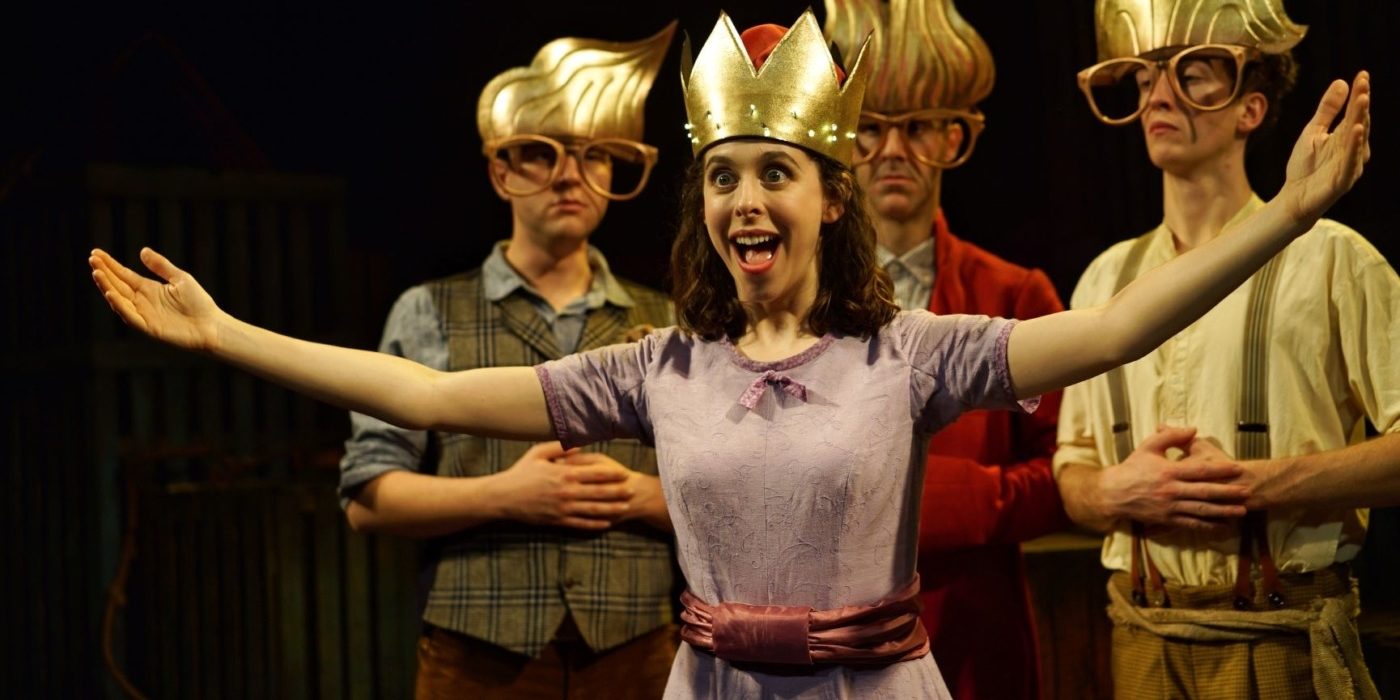“Entertainment for adult and child alike”: a review of ‘Wilde Creatures’
“Let those who come to play with me have no hearts,” cries (Lauren Silver’s) Princess Infanta, near the end of this remarkable production of Oscar Wilde’s fairy-tales by the Tall Stories theatre company. As a phrase, it represents the dark thread running through these warm, yet deceptively sly set of fairy tales, reworked into an hour-long quest to find a new statue for a town centre. The show is notionally children’s theatre, with its repetitive plot structure, told by a comic troupe of four musician-actors (the Wilde Creatures of the title) providing a hook for younger audiences to engage with Wilde’s moralistic stories.
The play opens with a framing device ripped right out of Wilde’s The Happy Prince, with the town mayor (Tom Jude) planning to erect a statue of himself for the new town centre. Jude plays the mayor with an exaggerated pomposity, giving off the conceited air of a panto villain brilliantly. His attempts to suggest a statue of himself are shot down by the other townsfolk, who in turn suggest character traits and ideals they’d like to see embodied by the statue.
Jude gives off the conceited air of a panto villain brilliantly
The first of these ideals is that of friendship, as represented by (Matt Jopling’s) Miller. The Miller is held up as the epitome of “true friendship” by the townspeople, and his friendship with Hans the gardener (Steve McCourt) is used as their main argument. This begins to ring hollow when we see how the Miller treats Hans, taking advantage of Hans’ kindness and giving nature. He continually swipes his flowers, to the extent where Hans must go hungry in the winter, as he hasn’t sold any flowers in the spring.
This is played off for comic effect initially, with Jopling’s character exploiting his friend by making him do increasingly slapstick chores, with McCourt coping admirably with the demands of essentially miming half a dozen menial tasks. It’s an incredibly funny sequence, and draws plenty of laughs from the audience, but soon the relationship between Miller and Gardner becomes quite unsettling. The plot takes a much darker turn, with McCourt standing out for managing to make use of limited stage space and only a lamp prop as an aid to evoke Hans’ sweet faithfulness and desperation. In doing so, he holds a previously giggling audience of mostly young children in suspense.
It draws plenty of laughs from the audience
With the Miller revealed to be both hollow and hypocritical, the audience vote against his image being the one on the statue. So, then we move on to the student (McCourt), held up as representing intellect. The tale of the lovesick student is clearly played for laughs, acting as a palate cleanser from the shockingly bleak ending to the Miller’s tale, with audience participation pushed to the forefront. The audience is asked to help the student with the love poem he’s writing, and the body parts he is asked to praise become increasingly ridiculous, drawing frequent laughs while confusing the hapless character on the stage further.
But as the student vainly searches for a red rose, the comic plot again takes a darker turn. A nightingale (Silver) sees in the pining student the full bloom of young love and decides to make a red rose by letting a thorn pierce her heart, sacrificing her life for his love. It then becomes clear that this is a play full of inversions and transformations, as clever as any of Wilde’s aphorisms, with a set of comic actors seemingly leading us on a cheerful journey before suddenly twisting us out of shape.
This is a play full of inversions and transformations, as clever as any of Wilde’s aphorisms
Once again, the audience reject the student, as he proves himself inadequate. So, we move on, if a tad formulaically, to Princess Infanta (played by Silver), as the epitome of beauty. The scene is no longer straightforwardly comic, with the story of the Princess and the wild boy (Jopling) who provides birthday entertainment becoming a surreal vignette, with the physicality of Silver and the woodland setting lending the scene a distinctly otherworldly quality. The scene with the hallway of statues to me is something nightmarishly Ovidian, holding a barely concealed menace.
While the play ends on a musical number and the audience gets to go home with a bag of seeds, this isn’t your ordinary Christmas fare. It casts a surprisingly dark spell, asking searching questions of its young audience, providing entertainment for adult and child alike.
Wilde Creatures is at the Arts Centre until 30 December. Tickets are available here.

Comments
Comments are closed here.